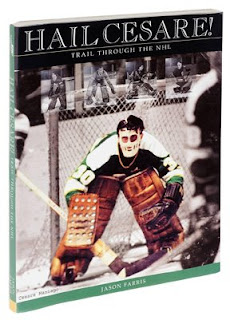 Author Jason Farris (see also Hockey Play-by-Play), a goalie at heart, set out to take a fresh approach to writing a hockey book. He certainly accomplished just that in his homage to his favorite hockey player since childhood - Cesare Maniago.
Author Jason Farris (see also Hockey Play-by-Play), a goalie at heart, set out to take a fresh approach to writing a hockey book. He certainly accomplished just that in his homage to his favorite hockey player since childhood - Cesare Maniago.Perhaps homage is not quite the right word. He has created an absolute shrine to a goalie best remembered for his days with the Minnesota North Stars and the Vancouver Canucks.
This book is an interesting undertaking, as it hints at several formats all in one. In doing so the book is visually appealing though quite unconventional.
Maniago was a very popular player in both Minnesota and Vancouver, as well as his many minor league stops where he served as arguably the best goalie outside of the 6-team NHL. His unique name and his valiant efforts made him the fan favorite of some real weak teams. He was at times as spectacular as his teams were bad.
Because he played on so many weak teams, he never received many accolades or notable success. He quite literally was these teams' saving grace, and Farris created this book partly to revise history's dismissal of this cult hero.
Through in-depth statistical analysis and comparison, Farris argues Maniago was a far better goalie than history remembers him as. His case is compelling. Farris uses statistical analysis far deeper than hockey's primitive measuring sticks such as wins and losses and goals against average. In doing so Farris makes a good case that we should hold Maniago in the same esteem we remember Gerry Cheevers, Tony Esposito, Rogie Vachon and Gilles Meloche.
This book really comes alive courtesy of two features.
First off, the use of scrapbook-like imagery in this book is a real treat. The vivid mixture of memorabilia and action photography is superb. It really is like flipping through someone's album of memories.
Secondly, Cesare Maniago contributes his own commentary which provides fascinating insight into a unique goalies in a unique era. Through these interviews the book teases of an autobiography.
I think my favorite Maniago insight was the time he and Boston's Eddie Johnstone pretended to fight in order to give the fans something to cheer about.
"I never really got into a fight with a goalie. Eddie Johnstone and I once pretended a bit for the fans that who really loved it when the goalies met at center ice curing during an altercation. He and I dropped the gloves and were hanging onto each other asking about each other's family. We'd let the other assholes go at it, mind our own business and just talk to each other. Then we'd tell each other to pretend to be mad as hell. Hhe'd tell me to get my right arm up like I was going to whack him and he'd do the same with his arm so we'd give the fans something to roar about."
The book challenges many publishing standards. Though it is unconventional, it works, albeit with some constructive notes of criticism.
The book is a little thin at just 56 pages, many of them full of only photos or statistics. Some more written text, either in the form of Maniago's own comments, Farris' memories or perhaps reflections from Maniago's peers could really provide much needed bulk to this project otherwise full of interesting side features.
The book also features awkwardly over sized pages, of which I'm not a big fan of. This is one industry standard that did not need to be challenged.
All in all, this book is absolute must have if you were ever a fan of Cesare Maniago. It is an interesting project for fans of hockey in the 1960s and 1970s. It is also worthy of perusal for younger fans curious about the great era of hockey gone by.
You can buy the book via the Hockey's Best Books website.
Comments